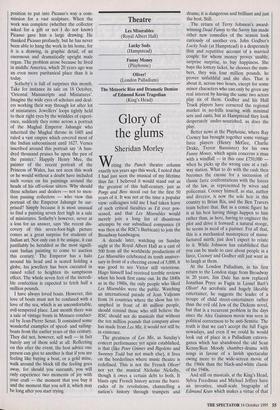Sale rooms
Perfect in
every way
Alistair McAlpine
Sotheby's has two sales this October which are of great interest to those who watch how prices move in the art market. The first one, the Grand-Ducal Collection of Baden-Baden, started on 5 October and ends on 21 October. You might expect to find bargains amongst the thousands of lots in this grand attic sale but you would, I am afraid, be deeply disappointed.
The second sale is of 'Impressionist and Modern Art and Ceramics' and starts on 25 October in London. Here you might expect prices to be high, but again you would be in for a surprise for the estimates are on the low side. It is a sale for the collector who collects paintings the way others collect stamps — the timid one who wants to buy safe pictures at safe prices. For relatively small amounts of money he can cover his penthouse walls in big names. These insignificant works by important artists make no end of an impression on acquain- tances when they are invited around for a plate of shepherd's pie and a glass of Krug.
If you have been in the habit of shopping around the great sale rooms of the world buying bargains over the last ten years, you might view the estimates that Sotheby's put on these offerings with dismay. For instance, lot 17, a ravishing small Renoir of fruit, approximately 6" by 7", is estimated at £20,000. I noticed a similar picture in a French gallery last week priced at £60,000. Even allowing a margin for profit, someone has got it wrong. Lot 38, a pair of unusual Dufy watercolours of Canna lilies, approxi- mately 25" by 20" is estimated at £20,000 and lot 48, a collage by Kurt Schwitters approximately 8" by 5", is estimated at f10,000. A small Ben Nicholson gouache dated 1979 is expected to fetch £8,000 and a painting by Leonor Fini, 'Femme au Grand Chapeau' (1967) is estimated at £12,000.
Lot 283 is a ceramic tile by Picasso, `Scene Erotique', which I regard as a mod- est title for a work that depicts a man with an erection at least a quarter his own height, chasing a lady whose breasts are swinging like a pair of church bells. I was very taken by this lot, because it reminded me of how Picasso treated one of the `stamp collectors'. This collector was in a position to put into Picasso's way a com- mission for a vast sculpture. When the work was complete (whether the collector asked for a gift or not I do not know) Picasso gave him a large drawing. He thanked Picasso profusely, but he has never been able to hang the work in his home, for it is a drawing, in graphic detail, of an enormous and dramatically upright male organ. The problem arose because he lived in middle America, which 20 years ago was an even more puritanical place than it is today.
Sotheby's is full of surprises this month. Take for instance its sale on 18 October, `Oriental Manuscripts and Miniatures'. Imagine the wide eyes of scholars and deal- ers working their way through lot after lot of miniatures. Jewellers' loops tightly held to their right eyes by the wrinkles of experi- ence, suddenly they come across a portrait of the Mughal Emperor Jahangir who inherited the Mughal throne in 1605 and ruled a vast empire which covered most of the Indian subcontinent until 1627. Verses inscribed around this portrait say 'A hun- dred thousand praises be upon the pen of the painter.' Happily Henry Mee, the painter of the recent portrait of the Princess of Wales, has not seen this work or he would without a doubt have included such verses on his paintings around the heads of his off-colour sitters. Why should these scholars and dealers — not to men- tion passing collectors — who view this portrait of the Emperor Jahangir be sur- prised? Simply because it is most unusual to find a painting seven feet high in a sale of miniatures. Sotheby's however, never at a loss for an answer, says 'the recent dis- covery of this seven-foot-high picture comes as a great surprise for students of Indian art. Not only can it be unique, it can justifiably be heralded as the most signifi- cant Indian painting to come to auction this century.' The Emperor has a halo around his head and is seated holding a globe, his jewellery has been executed in raised relief to heighten its sumptuous effect. The whole seven feet of the incredi- ble confection is expected to fetch half a million pounds.
I have always loved boats. However, this love of boats must not be confused with a love of the sea, which is an uncomfortable, evil-tempered place. Last month there was a sale of vintage boats in Monaco conduct- ed by Jean-Pierre Senat. It contained some wonderful examples of speed- and sailing- boats from the earlier years of this century. They did not, however, sell well — in fact barely any of them sold at all. Reflecting on this after the event, the best advice one person can give to another is that if you are feeling like buying a boat, or a gold mine, walk around the block till the feeling goes away, for should you succumb, you will only experience two moments of joy with your craft — the moment that you buy it and the moment that you sell it, which may be long after you start trying.











































































 Previous page
Previous page